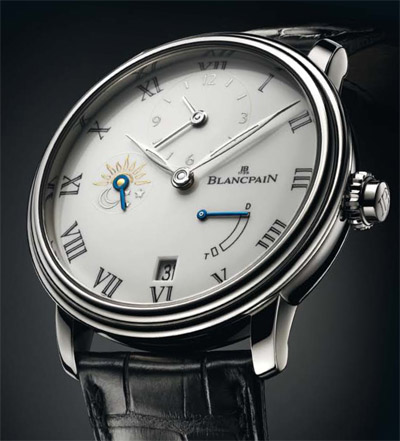Lettres du Brassus - No 09
Jeffrey S. Kingston
Does not the frequent traveler deserve a timepiece that eases the burden of long distance travel?
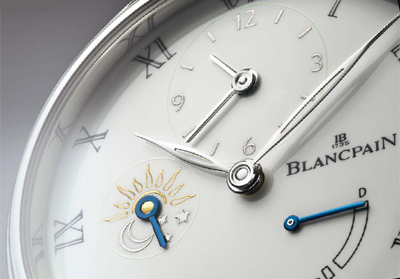
I am fortunate enough to have come of age when travel was glamorous. One dressed to board a plane. No, not in the detestable track suits that some don for long haul flights, but in properly pressed business suits, starched shirts, impeccable cravats or, if female, long dress hat, and, without fail, gloves. Imagine in those heady days, arriving at the airport and simply striding to the gate without disrobing at a security station or at the ever present conveyor belt, spreading one's belongings, as if offering them for sale at covered bazaar. As jumbo jets took hold, airlines scrambled to top one another in offering luxury aloft. Piano bars on the upper deck; reserved dining tables with proper linens set aside in the middle sections; racks of beef, veal or lamb carved on the trolley for dinner.
As we all have sadly witnessed, this gauzy travel dream world has been systematically dismembered and dismantled. Now instead of being carried along with a soothing string of comforting graces, the airline traveler is obliged to steel himself or herself to run a gauntlet of disagreeable assaults on dignity from the moment a foot is set inside the door of the airport until deposited outside the door at the destination. Where did the fun go? Who is the Grinch that stole away that calm world shown in airline advertisements of the 60s and 70s of well dressed passengers flashing thousand watt grins at beaming flight attendants stooping to accommodate every need?
However this state of affairs came to be, it is plain that it is here to stay. The annoyances of travel are not going to disappear anytime soon. So against this backdrop, enter the travel watch. Has not the frequent traveler earned and does he not rightly deserve a timepiece that not only eases one of the burdens of long distance travel, namely, without fuss, keeping track of both home time and local time, but one that, as well, is guaranteed to bring pleasure every time a gaze falls upon it? One that every time it is used provides a satisfying interlude, a bit of insulation from the grating travel annoyances that otherwise bombard an intrepid voyageur.
This is the sentiment that Blancpain had in mind when it conceived two new Villeret double time zone watches that were unveiled at Basel 2011. It set out to create timepieces that would be agreeably easy to use, be fully adapted to all major destinations on earth, and do so with elegance and style. These two Villerets, one 40 mm in diameter offering a 72 hour power reserve, the other 42mm in diameter and boasting a full eight day power reserve, conform to one of Blancpain's time tested design conventions for travel watches with two sets of time hands; the small set of hands located at twelve o'clock for the display of home time and a large set of hands positioned at the center of the dial for showing local time. This double fuseau horaire (the watchmaking term for two separate but full time displays on a single dial) layout is perfectly conceived to show at a glance both home time and local time without the slightest possibility of confusing the two.
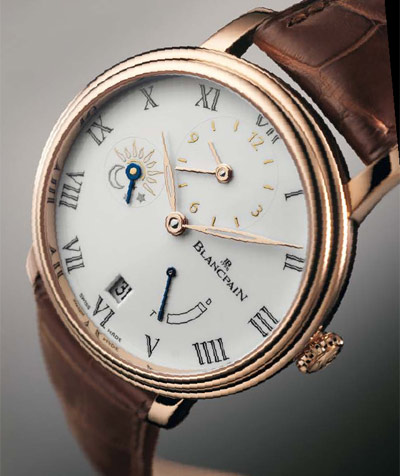
Although the display of home time and local time follows longstanding Blancpain practice, both of these models feature significant advances in functionality. As in the past, the setting of local time is accomplished via the crown. When the crown is in the setting position the local time indication advances in a series of fixed jumps, while the home time indication in the subdial at 12 o'clock remains unchanged. In this respect, too, the new models are similar to their forbearers. What is revolutionary is the accommodation to half time zones.
Previous models jumped local time in fixed one hour increments, which although suitable for many cities on earth, does not take account of many important locales such as Delhi, Caracas, or Kabul, to name a few. According to local governmental decrees, these and other similar cities, have adopted a convention establishing local time half an hour separated from time zones on either side. In order to allow the new Villeret watches to be used everywhere on the globe with equal convenience (except for two or three obscure islands that have seen fit to define their time zone as one quarter of an hour apart from an adjacent time zone), Blancpain outfitted both watches with a movement that jumps the local time indication in half hour increments. The realization of half hour jumps in the setting of local time requires far greater complexity in the GMT components of the movement than previous models that only jumped the hour hand. The reason is only logical. Instead of moving just one local time hand in precise hour increments, the new Villeret's now possess the components to jump both hands, hour and minute, in precise half hour segments. Thus, by fashioning the GMT mechanism to move both the hour and minute hands by the half hour, these new Villerets may be perfectly set for every single important time zone on earth, no longer are the major half time zone cities left out of the equation.
Blancpain also conceived a second major advance associated with the setting of the watch. In previous Leman and Villeret double fuseau horaires models date setting would be accomplished by pulling the crown to first position (also used for jumping of the hour hand in setting local time — one hour increments in the earlier watches). To move from one date to another the local time hour hand would be rotated through as many days, forward or backward, as required to reach the correct date. Thus, in the previous models, in common with industry practice for virtually all similar double time zone watches, there was no rapid direct method for setting the date. The new Villeret watches both address this inconvenience by providing for direct rapid date change without the necessity of turning the local time settings through successive days.
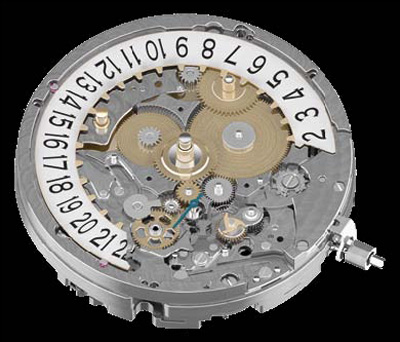
Blancpain has created an ingenious system for controlling three functions with the crown
To accomplish this feat of rapid date setting Blancpain developed a switchable crown. The crown is fitted with a switching button which operates co-axially. As the button is pushed the crown's function in position “1” switches back and forth between setting of the local hand GMT time (that is half hour changes back and forth) and setting of the date. A small hand between the 4 and 5 o'clock position on the dial indicates whether the crown is set to change the GMT time on the local hands or to set the date. Thus, when the owner wants to move the GMT local time hands for a time zone change, all that is required is to push the button until the small hand indicates “T” (for time), pull the crown to the first position and turn it until the desired time zone is reached (of course the home time indication at the 12 o'clock subdial will remain unchanged). Or if the date is to be set, push the crown button until the hand indicates “D” (for date), pull the crown to the first position and then turn for rapid date setting. Of course, if the date has already been properly set for home time on the watch and local time is advanced or retarded through midnight, the date will automatically change, with no manual intervention needed.
The development of the crown function switching mechanism took Blancpain's movement designers, of all places, to their repertoire of chronograph techniques. All of Blancpain's chronographs use a component known as a column wheel for the control and management of the chronograph's complicated start/stop/return to zero functions. Not only do column wheels provide great precision in the control of functions, they endow any pusher with an unmistakable creamy smooth touch and feel when actuated. Both because of this precision and silky feel, column wheel control for chronographs has rightly earned its place as a mark of a top grade timepiece (and similarly chronographs lacking column wheel control betray a cheapness in design, which although pleasing to accountants looking to save money, are not fitting to fine haut de gamme timepieces). So borrowing a page from its chronographs, Blancpain implemented its crown function switching with a column wheel. Of course there were simpler ways to construct a function switch, but by utilizing a column wheel Blancpain's movement designer's insured that the switch would be utterly precise in switching between the time and date functions and furthermore that the feel of the button would be satisfyingly smooth every time it was pressed.

The use of a sophisticated column wheel switching mechanism endows the crown pusher with a refined feel
The genius of the column wheel design is shown in diagrams 1 and 2. In diagram 1, the movement is in the time setting position. The column wheel is shown as B. There are two main components of the column wheel. At the lower level are teeth which engage with the pusher A. At the upper level are the “columns” or as they are sometimes termed, “pillars”. These pillars form a series of protruding “posts” which alternate with the “troughs”. In the time position shown in diagram 1, the large lever, C, is resting on one of the protruding posts. This causes the lever to position itself so that the gear train of the crown, E, engages with the GMT time wheel, F. The refinement of a column wheel control, is shown in diagram 2 which illustrates what happens when the pusher A is depressed again. The effect of the push is to rotate the column wheel, B, clockwise. That rotation, in turn, causes the finger of large lever, C, to move from riding on one of the pillars, to fall instead into a trough.
As a result of this change in position, the gear train, E, is disconnected from the GMT time wheel and instead is managenow positioned where the three toothed wheel, I, can engage the exterior date ring of the movement. Simultaneously with this change, the ratchet, G, moves clockwise, changing the position of the hand, H, which indicates on the dial whether time or date has been selected. There is one other element which has been incorporated into the date changing system; Blancpain has made it totally secure. As sophisticated connoisseurs know, there is a problem with most date mechanisms if a manual change is attempted during the period (usually around midnight) when the movement is in the course of automatically advancing the date. This is because gears are already engaged to effectuate the change to the next day so that manual intervention risks breaking delicate teeth. In order to prevent the risk of this occurring with the new Villerets, Blancpain secured the movement from the risk of damage by disconnecting the manual system during the period surrounding midnight. If a date change is attempted during this time, the crown can be freely turned without risk of breakage. Are there switching systems which are simpler? Of course, however, none rival the sophistication of the column wheel and, most important, none endow the watch with the refined pusher feel that the column wheel produces.
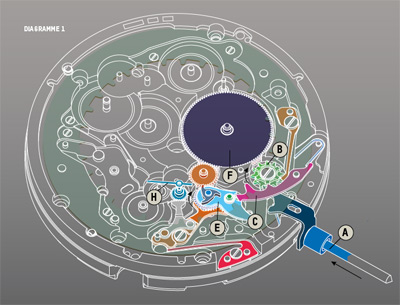

Both Villerets complete their displays in the same fashion with a day/night indicator located at 9 o'clock. As it should be, the day/night hands of both watches remain linked to home time, thus displaying whether the home time hands are showing am or pm. One would fervently hope that the owner would need no similar prompting with respect to local time as a look outside the window would suffice.
The 8 day power reserve 42mm versions are the flagships. Two variants will be available, one in red gold the other in white gold. Each will be fitted with a full fired, bombé enamel dial. The day/night indicator received special attention as the daytime sun design is created by a special process that deposits gold on the top enamel layer, the evening design, which, of course, presents the moon, with a deposit of platinum. The automatic winding movement features a free sprung titanium balance with gold regulation screws and three mainspring barrels.
